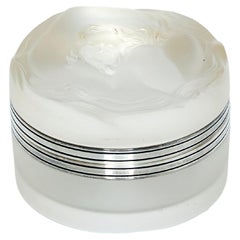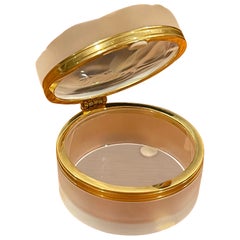Lalique Daphne
Recent Sales
Vintage 1940s French Art Deco Decorative Boxes
Crystal
Mid-20th Century French Art Deco Jars
Crystal
Vintage 1940s French Art Deco Decorative Boxes
Lalique for sale on 1stDibs
Lalique is a beacon of French opulence in glassmaking and decorative arts, an enduring brand with a history spanning over 130 years and at least three movements in art and design: Art Nouveau, Art Deco and modernism. The firm’s founder, René Lalique, is a celebrated figure in Art Nouveau jewelry, which drew on feminine forms and natural-world themes. Under his masterful leadership, Lalique came to be known for its gorgeous vases, sculptures and glass and crystal serveware.
Rene Laliqué was born in 1860 in Aÿ-en-Champagne, France. As a young man, he apprenticed under Parisian Art Nouveau jeweler Louis Aucoc and studied at L'École nationale supérieure des Arts Décoratifs. Lalique's skill and esteem broadened, and he created jewelry for renowned houses like Cartier and Boucheron. He took over a workshop in Paris in 1885 and opened his own business soon afterward. Not one to follow trends, Lalique gained popularity for his innovative accessories, which merged glass, enamel and ivory — materials that were uncommon in jewelry-making — with semi-precious stones and metals. Lalique’s work gained greater prominence at the 1900 Paris Exhibition, which served as a showcase for his extraordinary designs.
In 1907, Lalique began a revolutionary partnership with French perfumer François Coty. He designed a line of molded glass perfume bottles with frosted surfaces and patterned reliefs. Lalique opened his eponymous glassworks in Combs-La-Ville, Paris, in 1909. His attractive bottles and other pieces were shown at the International Exhibition of Modern Decorative and Industrial Arts in 1925 — the event that brought Art Deco to worldwide attention — catapulting Lalique to new levels of fame. Shortly afterward, in 1927, he created one of his most iconic pieces: the Bacchantes vase. A marvel of glassmaking that convincingly depicted movement, the vase displays his technical skills and artistry.
Lalique began receiving high-profile commissions — in 1929, he decorated the luxurious Côte d’Azur Pullman Express carriages, and in 1935, he designed lighting for the Grand Salon and dining room on the ocean liner SS Normandie.
Lalique died in 1945, and the reins at the company were passed to his son, Marc Lalique. The firm continued to produce its signature glass pieces as well as crystal vases, decor and serveware. Marc's daughter, Marie-Claude Lalique, became CEO in 1977. She renewed the traditional jewelry and fragrance side of the business. In 2008, Lalique was acquired by Art & Fragrance, now known as Lalique Group. It remains a well-regarded lifestyle brand underpinned by a rich history in glassmaking.
On 1stDibs, find vintage Lalique decorative objects, lighting, tables and more.
A Close Look at art-deco Furniture
Art Deco furniture is characterized by its celebration of modern life. More than its emphasis on natural wood grains and focus on traditional craftsmanship, vintage Art Deco dining chairs, tables, desks, cabinets and other furniture — which typically refers to pieces produced during the 1920s and 1930s — is an ode to the glamour of the “Roaring Twenties.”
ORIGINS OF ART DECO FURNITURE DESIGN
- Emerged in the 1920s
- Flourished while the popularity of Art Nouveau declined
- Term derives from 1925’s Exposition Internationale des Arts Décoratifs et Industriels Modernes (International Exhibition of Modern Decorative and Industrial Arts) in Paris, France
- Informed by Ancient Egypt, Cubism, Futurism, Louis XVI, De Stijl, modernism and the Vienna Secession; influenced Streamline Moderne and mid-century modernism
CHARACTERISTICS OF ART DECO FURNITURE DESIGN
- Bold geometric lines and forms, floral motifs
- Use of expensive materials such as shagreen or marble as well as exotic woods such as mahogany, ebony and zebra wood
- Metal accents, shimmering mirrored finishes
- Embellishments made from exotic animal hides, inlays of mother-of-pearl or ivory
ART DECO FURNITURE DESIGNERS TO KNOW
VINTAGE ART DECO FURNITURE ON 1STDIBS
Few design styles are as universally recognized and appreciated as Art Deco. The term alone conjures visions of the Roaring Twenties, Machine Age metropolises, vast ocean liners, sleek typography and Prohibition-era hedonism. The iconic movement made an indelible mark on all fields of design throughout the 1920s and ’30s, celebrating society’s growing industrialization with refined elegance and stunning craftsmanship.
Widely known designers associated with the Art Deco style include Émile-Jacques Ruhlmann, Eileen Gray, Maurice Dufrêne, Paul Follot and Jules Leleu.
The term Art Deco derives from the name of a large decorative arts exhibition held in Paris in 1925. “Art Deco design” is often used broadly, to describe the work of creators in associated or ancillary styles. This is particularly true of American Art Deco, which is also called Streamline Moderne or Machine Age design. (Streamline Moderne, sometimes known as Art Moderne, was a phenomenon largely of the 1930s, post–Art Nouveau.)
Art Deco textile designers employed dazzling floral motifs and vivid colors, and while Art Deco furniture makers respected the dark woods and modern metals with which they worked, they frequently incorporated decorative embellishments such as exotic animal hides as well as veneers in their seating, case pieces, living room sets and bedroom furniture.
From mother-of-pearl inlaid vitrines to chrome aviator chairs, bold and inventive works in the Art Deco style include chaise longues (also known as chaise lounges) and curved armchairs. Today, the style is still favored by interior designers looking to infuse a home with an air of luxury and sophistication.
The vintage Art Deco furniture for sale on 1stDibs includes dressers, coffee tables, decorative objects and more.
Finding the Right decorative-objects for You
Every time you move into a house or an apartment — or endeavor to refresh the home you’ve lived in for years — life for that space begins anew. The right home accent, be it the simple placement of a decorative bowl on a shelf or a ceramic vase for fresh flowers, can transform an area from drab to spectacular. But with so many materials and items to choose from, it’s easy to get lost in the process. The key to styling with decorative objects is to work toward making a happy home that best reflects your personal style.
Ceramics are a versatile addition to any home. If you’ve amassed an assortment of functional pottery over the years, think of your mugs and salad bowls as decorative objects, ideal for displaying in a glass cabinet. Vintage ceramic serveware can pop along white open shelving in your dining area, while large stoneware pitchers paired with woven baskets or quilts in an open cupboard can introduce a rustic farmhouse-style element to your den.
Translucent decorative boxes or bowls made of an acrylic plastic called Lucite — a game changer in furniture that’s easy to clean and lasts long — are modern accents that are neutral enough to dress up a coffee table or desktop without cluttering it. If you’re showcasing pieces from the past, a vintage jewelry box for displaying your treasures can spark conversation. Where is the jewelry box from? Is there a story behind it?
Abstract sculptures or an antique vessel for your home library can draw attention to your book collection and add narrative charm to the most appropriate of corners. There’s more than one way to style your bookcases, and decorative objects add a provocative dynamic. “I love magnifying glasses,” says Alex Assouline, global vice president of luxury publisher Assouline, of adding one’s cherished objects to a home library. “They are both useful and decorative. Objects really elevate libraries and can also make them more personal.”
To help with personalizing your space and truly making it your own, find an extraordinary collection of decorative objects on 1stDibs.
- 1stDibs ExpertNovember 2, 2021Since the mid-twentieth century, Lalique has been internationally recognized for its decorative objects as well as non-glass items produced in crystal. The career of the famed jewelry designer, glassmaker and decorative artist René Lalique spanned decades and artistic styles. Best known today for his glass art, vases, chandeliers and more, Lalique first won recognition for his jewelry. Find a collection of Lalique glass on 1stDibs that includes serveware, decorative objects and other furniture.

